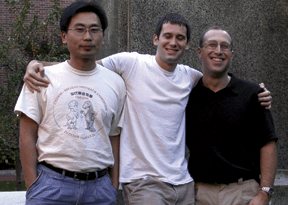
Both Jerald Harris Gr’04 and Matthew Lamanna G’99 Gr’04 describe themselves as dinosaur-obsessed kids who “never grew up,” and maybe they’re right. After all, they still spend their days playing with ancient bones and digging for buried treasure—they just do so on a much larger scale, and often with valuable results.
Since 2004, Harris and Lamanna have helped their friend and former Penn classmate Hai-lu You Gr’02 locate and classify nearly 100 fossils of gansus yumenensis, a pigeon-sized bird that lived about 110 million years ago in China.
A recent report on their findings titled “A Nearly Modern Amphibious Bird from the Early Cretaceous of Northwestern China,” published in the June 16 issue of Science, has created a buzz in the scientific world. Some experts call the three men’s discovery the “missing link” in bird evolution—a description Harris is hesitant to verify.
“‘Missing link’ is a term scientists hate,” he says. “But these fossils do tell us that skeleton features in birds go back much farther than anyone had anticipated before. Gansusis not a direct ancestor of a particular modern bird, but it’s very close to the common ancestor of all modern birds.”

Like its predecessors, the gansus probably had teeth, claws, and dense bones—features that differentiate it from more modern birds. However, it also had webbed feet and a large, crested breast bone, which are traits more common in present-day birds than in prehistoric ones.
“All these features show that it’s not quite modern, but it’s really, really close,” Harris says.
A team of researchers first discovered the one-of-a-kind specimens in 1981 when searching for fossilized fish in the Gansu province of northwest China. Though the scientists named and classified the single fossilized bird foot they found, no other researchers attempted to collect more samples for the next two decades.
“To be honest, we really don’t know why,” Harris says. “Maybe it was too remote a locality. Maybe people had too many projects going on. Or it may have just been a logistical problem.”
Lamanna attributes the lack of excavation there to similar factors, including another find of fossilized birds in northeastern China at a site much closer to Beijing—and much more accessible—than the Gansu province.
Despite these deterrents, shortly after he received his graduate degree from Penn, You became involved in several archaeological projects in China through the Chinese Academy of Geological Sciences, including heading the first group to return to the Gansu site to hunt for more fossilized birds.
“Hai-lu and his team went to the site and found quite a bit of material—enough to suggest that he could get a really good project going there,” Harris says.

Almost immediately, You thought of Harris and Lamanna, the two Penn classmates who’d shared his passion for paleontology. As graduate students, the three men had frequently unwound with a few drinks at the New Deck Tavern or stopped for a quick bite at one of the food trucks.
“We were really close,” Harris says. “The earth and environmental-science department has a very tight, close-knit group of graduate students. We all got to be really good friends.”
So when You realized the site he had to work with, he “called Matt and me up and said, ‘Hey, you want to get in on this?’ and of course we jumped at the chance,” Harris recalls.
You also contacted Peter Dodson, professor of anatomy in the School of Veterinary Medicine and professor in the Department of Earth and Environmental Sciences, who had been an advisor for all three men [“Gazetteer,”Sept/Oct 2004].
“The Asian culture really values a respect for elders and mentors,” Dodson says. “Hai-lu didn’t need to include me in his research projects, but I’m absolutely delighted that he did.”
Though Harris was unable to accompany Lamanna and Dodson on their first trip to Gansu in 2004, all three men took time off from their full-time jobs in 2005—Harris works for Dixie State College in Utah and Lamanna for the Carnegie Museum of Natural History in Pittsburgh—to travel to the remote corner of China that Harris says is “about as far away from the ocean as any place else in the world.” (The Gansu site is near a small farming village—with a population of about 100—that is an hour outside the small city of Yumen.)
“The local people are really friendly, the scenery is spectacular, and the food is great,” Lamanna says, describing his summer in China as “awesome.” Though Lamanna and Harris have been back in the U.S. for more than a year now, both say they are eager to return to the site to find more specimens and conduct further research.
“We need to get back into the field and start doing some actual geological work,” Harris says. “We’re applying for grants and trying to get back next summer.”
The paleontologists also need to piece together the specimens they have, since the team has yet to uncover one that is complete from head to toe. (The closest they have right now is neck to toe.)
“We can actually detail its anatomy probably better than any other bird from this time period has ever been,” Harris says. “But we need to spend time in the lab with the new specimens so we can pinpoint [gansus’] position on the evolutionary tree much more precisely.”
As for Dodson—who plans to go back with them since “you can’t keep me out of China”—watching the three young minds he fostered at Penn succeed in the field has been a highly rewarding experience.
“It’s just a wonderful privilege to have students of the quality of Matt, Jerry, and Hai-lu,” he says. “I’m exceedingly proud of all three of them. My students as a group have set about making me look good, and I feel that they run circles around me.”
—Molly Petrilla C’06




